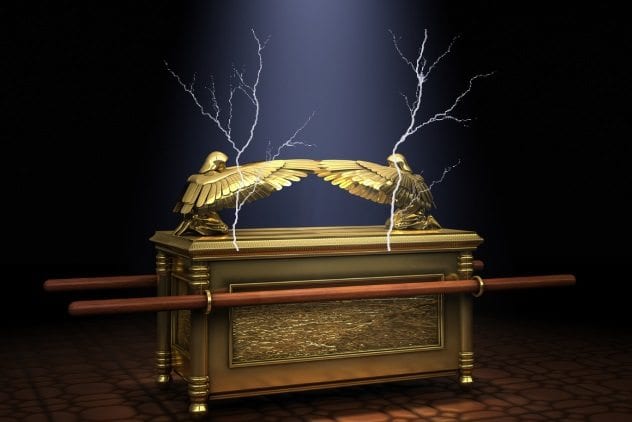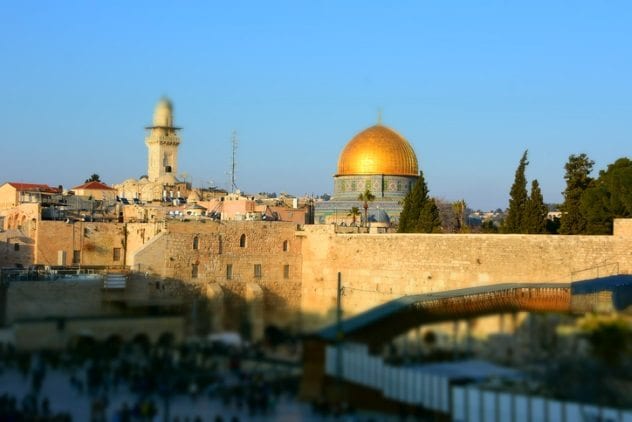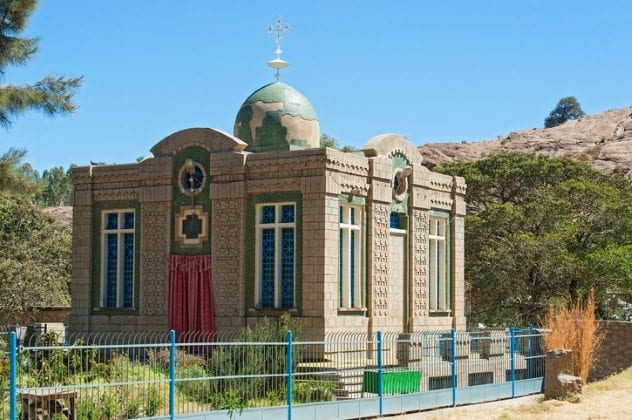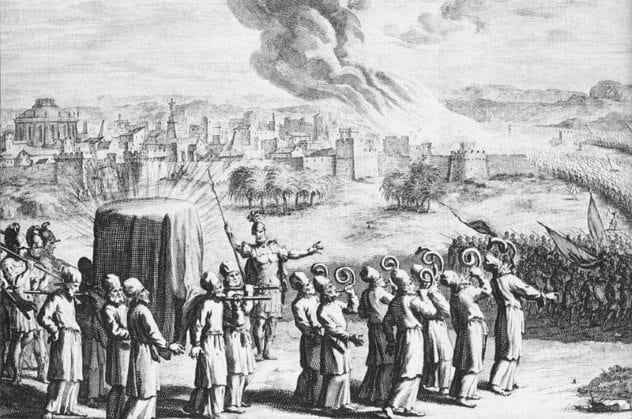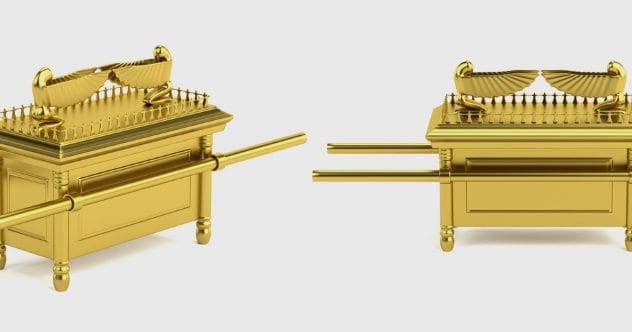To some, however, the Ark is far from mere legend and is not only very real but an object worth the time, money, and even ridicule to try to recover. Indeed, if anyone were to ever locate the lost Ark, it would surely be one of the greatest finds in recorded history. Of course, there are some who believe they know exactly where the Ark is, and their claims are among many intriguing, unlikely, and even outlandish theories concerning the Ark of the Covenant.
10 Extraterrestrial Origin
For those who subscribe to ancient astronaut theory, this is a given. And their reasoning, even if you don’t buy into it, makes a certain amount of sense. When Moses was summoned to Mount Sinai, some believe it wasn’t God he was meeting but rather that he was taken aboard a spacecraft that awaited him at the top of the mountain. When Moses returned, he had a “glow” about him, but he also seemed to have aged considerably. Although there is no way to prove it, theories suggest that this was due to the amount of time he had spent “in space,” learning all that God (aka the aliens) had to teach him. Not only did he return with the two stone tablets with the famous commandments, but he also carried the blueprint and the know-how for building what would be the Ark of the Covenant. If the Ark did exist in reality, then the idea that it was of extraterrestrial origin—or at least from some unknown, advanced civilization—isn’t that much of a stretch of the imagination, especially when you read what ancient writings describe the Ark as being used for.
9 It Was A Communication Device
Some firmly believe that the Ark of the Covenant was a device for communicating with peoples unknown, although to the Israelites on their exodus, it was a means to communicate with God. While these theories are speculative at best, they are reasonably well–thought out, based on writings and accounts in various ancient texts, including the Bible. When active, it was said that the image of God would appear in between the two cherubs that reside on top of the Ark, known as the Mercy Seat. There are several takes on what this may have been in reality. Some argue that the appearances of God in the Bible, for example, are often depicted as flames or smoke or bright lights. Given that many believe the Ark to have been some kind of electrical device (which we will look at later), it is possible that when it was “activated,” there would have been sparks and flashes that some may have taken as a sign of God. A somewhat more extreme theory is that the Ark was literally a communication device that created a hologram of the person on the other end. To those who were not at all familiar with such technologies, the suggestion that this was, in fact, God would have made perfect sense to them.
8 The Manna Machine
According to legend and ancient writings, during their 40-year exodus, the Israelites survived by obtaining sustenance from something called manna. This manna would fall from the sky, apparently on “the command” of the Ark itself. According to authors Rodney Dale and George Sassoon, the Ark was a working machine that produced this manna. It was essentially, as the title of their book suggests, a manna machine. The authors, using the Kabbalah as their source, claimed that the Ark housed a machine that was nuclear-powered and would produce manna on a daily basis, very similar to modern projects looking to supply algae as food. They even went as far as to say that this is where the origins of the seventh day being a day of rest stem from, as after running for six consecutive days, the machine would have to be taken apart and cleaned so that it remained in good working order.
7 It Was An Electrical Capacitor
When modern scientists and electrical engineers study the dimensions and materials of the Ark as dictated in the Bible, most agree that in reality, it resembles very much some kind of electrical capacitor. The Ark was made from wood and then completely covered in gold, inside and out. The wood could have essentially acted as an insulator between the positive charge (the outer plating) and the negative charge (the inner plating). The cherubs were placed on top of the lid of the Ark, itself also plated in gold on both sides. The positive cherub would be attached to the outer plating, while under the negative cherub would be another layer of wood to act as an insulator, with a rod connecting the negative cherub to the inner plating. If this were true, it would perhaps explain why there are so many stories of people dying when coming into contact with the Ark. For example, the story of Moses’s brother, Aaron, whose two sons were “burned from the inside” when a lightning bolt shot from the Ark and into their nose, would perhaps be explained by the fact that the Ark was electrically charged and volatile.
6 It’s At The Temple Mount
There are various claims and rumors that the Ark is at the Temple Mount. Perhaps the most controversial of these happened in 1981. Rabbi Yehuda Meir Getz secretly tunneled into the Western Wall and under the Temple Mount. He was certain he had pinpointed the location of the infamous Ark. However, the noise of his illegal excavation soon alerted authorities, not to mention angry residents. The project was shut down, and the tunnel system was blocked off. Getz would consistently say until the day he died that he was “but 40 feet away” from the Ark of the Covenant. Incidentally, there are many UFO sightings over this sacred patch of land, leading many who subscribe to ancient astronaut theory to believe that there is indeed a connection between legendary ancient relics and extraterrestrials from another world.
5 Secret ‘Code’ Discovered During Carpet Change At The Temple Mount
In 2015, a story appeared, which claimed that a secret code that may tell of the location of the Ark had been uncovered after a carpet, due to be changed, was ripped up under the Dome of the Rock. Before the “code” could be deciphered—or even photographed and documented for that matter—it had been covered over with the new carpet. This led to anger and accusations between Jewish and Muslim scholars and leaders, and although it didn’t result in violence, it demonstrated the importance of both the site and the possible remains of the relic to those who live in the region.
4 It Lays Guarded In Aksum
Some people firmly believe that the Ark rests to this day in a small church in Ethiopia. The Cathedral of St. Mary of Zion in Aksum is claimed to house the ancient relic and is under constant guard from a specifically selected priest of the church. Author Graham Hancock spent considerable time in Aksum in the early 1990s. He got to know several of the priests, who claimed to have guarded the Ark of the Covenant. He made specific reference to how quickly these chosen priests seemed to become ill and die shortly after taking the position. He also claimed that one of the priests in particular stated to him, completely as a matter of fact, that the Ark resided within the small church. A story in 2011 appeared online that even claimed the Ark was going to be relocated from the church in question due to a leak in the roof. The report should obviously be treated with a huge pinch of salt, but it is interesting nonetheless.
3 It’s At Rosslyn Chapel
Rosslyn Chapel is a conspiracy within itself, so it is perhaps not surprising that it also lays claim to having the Ark of the Covenant safely tucked away within its walls. According to most legends, the Ark was brought to the chapel by the Knights Templar, who traveled through France and eventually crossed the English Channel and made it to Scotland. Whether there is any truth to these accounts is obviously very much up for debate. However, many people have searched in various places along the supposed track of the Knights Templar—including, interestingly enough, teams led by the Nazis in the run-up to World War II. The areas around Rosslyn Chapel are also said to be a hot spot for UFO activity, with some of the more far-out theories claiming that the ancient church actually sits upon a portal that can be opened from within its walls.
2 It Was A Dangerous Weapon
There are many deaths associated with the Ark. For example, only those with the correct breastplate and gown could approach it safely. From a modern perspective, the plate and gown might have been protective clothing from radiation. It is claimed in writings that such areas as the head, lungs, and genitals all had to be covered when approaching the Ark. The story of the Walls of Jericho is seen as perhaps the best example of the alleged power of the Ark and how it was utilized as a weapon. The Israelites were instructed to march around the walls of the city, carrying the Ark with them as they did so. On the seventh day of doing this, following the sounding of their horns, the walls tumbled to the ground. While no one knows for sure if the walls did literally fall to the ground, many people believe that if they did, then it is likely that the Ark utilized some kind of pulse or sonar technology. As far-fetched as it sounds, there are “weapons” in development today that work in similar ways to how the Ark is theorized to have.
1 There Were Multiple Arks
Most people believe that there is only one Ark of the Covenant, but ancient texts suggest this was not the case and that at least one more, if not many more, existed. This second Ark was to remain completely hidden away, under the Tabernacle and out of sight from prying eyes, be it those of the Israelites’ enemies or the curious ones of their own people. With that in mind, perhaps the different theories as to its current location may all prove to be correct. If the Arks were all-powerful technological devices, and there were more than one, then they would be split up and hidden in different locations. Read More: Twitter Facebook Me Time For The Mind



